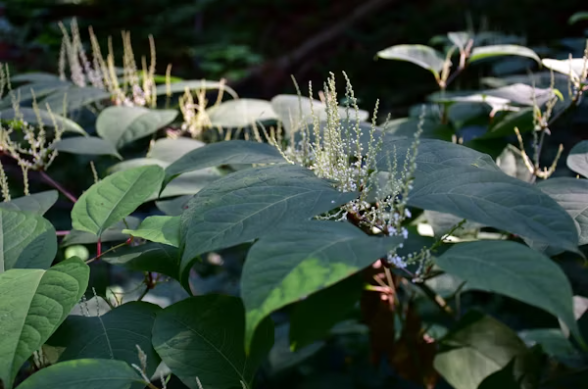
If you notice Japanese Knotweed on your property, promptly take action. Identify it by its heart-shaped leaves, bamboo-like stems, and cream-colored flowers. Its fast growth can greatly harm structures and decrease property value. It’s even a legal issue, as mismanagement or improper disposal can lead to penalties.
If you’re confident, try DIY removal – wear protective clothing, cut it down, dig out the roots, and dispose of the waste responsibly. But be aware, it’s known for regrowth. You might want to hire a professional exterminator.
Either way, continuously monitor the area afterward and consider disclosing it to your insurer. Keep going to understand more legal, management, and insurance measures.
Identifying Japanese Knotweed
Its defining features include heart-shaped leaves, bamboo-like stems, and clusters of small, cream-coloured flowers. It’s a perennial – which means it’ll reappear year after year once it’s established.
In spring, you’ll see reddish-purple shoots emerging from the ground, growing rapidly into dense stands of hollow, bamboo-like stems that can reach up to 3 meters in height. These stems are green with reddish speckles and have distinct nodes, similar to bamboo.
The leaves are broad and shovel-shaped, growing alternately along the stem. They’re bright green, about 15cm long, and have a pointed tip.
In late summer, you’ll witness clusters of small, cream-colored flowers blooming. By autumn, the leaves turn yellow and wilt, but the canes remain standing, turning brown and drying out, resembling dead bamboo. Even in winter, the dried cane can help you identify it.
Understanding the Threat
Identifying Japanese Knotweed marks the initial phase; comprehending its peril holds equal significance. This invasive species, indigenous to East Asia, poses a significant threat across various regions worldwide.
With its robust growth rate and rapid dissemination, Japanese Knotweed poses a formidable menace to natural ecosystems and constructed environments.
Capable of sprouting up to 10 centimetres daily, Japanese Knotweed swiftly dominates surrounding vegetation, obstructing sunlight and diminishing biodiversity.
It displays remarkable adaptability, thriving in diverse habitats ranging from riverbanks to residential gardens. Its extensive rhizomes, extending horizontally up to 7 meters and vertically up to 3 meters, wreak havoc on foundations, walls, and drainage systems.
However, the concern transcends mere physical damage. The presence of Japanese Knotweed can precipitously devalue properties. It represents a veritable nightmare in real estate transactions, as many lenders exhibit reluctance to extend mortgages for properties plagued by this invasive weed.
Effective management strategies, such as professional knotweed removal in Scotland, are imperative to mitigate its impact and safeguard the environment and property values.
Legal Obligations and Knotweed
Regarding Japanese Knotweed, it’s not just about environmental threats; there are also legal obligations you need to be aware of. Failing to control this invasive plant can lead to serious legal consequences. In the UK, for instance, it’s deemed a criminal offense under the Wildlife and Countryside Act 1981 to allow this plant to spread.
If you’re a property owner and knotweed from your land encroaches onto neighboring properties, you could be held responsible. It’s seen as a nuisance under common law. You might face legal claims for damages, especially if the plant’s growth causes structural damage to a neighbor’s property.
Moreover, if you’re selling property, it’s a legal requirement to disclose the presence of Japanese Knotweed. Non-disclosure could result in potential legal disputes down the line.
On a global level, many countries have laws against the improper disposal of knotweed. It’s usually classified as controlled waste under environmental protection regulations, meaning it must be disposed of at licensed landfill sites.
DIY Knotweed Removal
If you’re considering tackling Japanese Knotweed on your own, it’s important to understand that DIY removal requires careful planning and execution. This invasive plant is persistent and can regrow from tiny fragments left in the soil. Hence, you must be thorough, vigilant, and patient.
Start by identifying the Knotweed. It has bamboo-like stems, heart-shaped leaves, and produces creamy-white flowers in late summer. Once you’re sure it’s Knotweed, don your protective clothing and gloves. This isn’t a plant you want to handle with bare hands.
Cut the Knotweed back to ground level, then dig out as much root as possible. Bag up all the plant material securely. Be careful not to drop any fragments, as these can lead to regrowth. Dispose of the waste responsibly; environmental legislation defines Knotweed as ‘controlled waste’.
After this, you’ll need to monitor the area for regrowth regularly. If new shoots appear, cut them back immediately. This may need to be repeated for several years until the plant is entirely eradicated. It’s a long process, but with persistence, you can conquer the Knotweed menace in your garden.
Hiring a Professional Exterminator
In spite of your best DIY efforts, you might find that the persistent Knotweed proves too stubborn, in which case, it’s a good idea to bring in a professional exterminator. This isn’t a decision to be taken lightly, as the costs can be substantial. However, a professional has the knowledge and resources to eradicate Japanese Knotweed effectively.
When selecting an exterminator, make sure they’re certified by a recognized pest management association. They should also have specific experience with Japanese Knotweed. Don’t hesitate to ask for references or check online reviews. Consider getting quotes from different companies to compare prices and services.
Once hired, the exterminator will typically conduct an initial assessment to determine the extent of the infestation and the best course of action. They’ll then apply a systemic herbicide, which is absorbed by the plant and transported to its roots, killing it from the inside out. This process may need to be repeated over several months to ensure complete eradication.
Preventing Knotweed Regrowth
Once you’ve successfully eradicated the Japanese Knotweed, it’s important to take steps to prevent its regrowth. This isn’t a task you can afford to take lightly. Knotweed can regenerate from tiny fragments of rhizome, the underground part of the plant, making it an extremely tenacious weed.
Firstly, monitor the area where the knotweed was located. Regular checks will allow you to spot any new growth early and take action. It’s also wise to inspect surrounding areas as knotweed can spread through its root system.
Secondly, consider planting other vegetation to compete with any potential knotweed regrowth. Hardy native plants that spread quickly can help discourage knotweed. However, be sure to choose plant species that aren’t considered invasive themselves.
Conclusion
So, if you spot Japanese Knotweed, don’t panic! Identify it, understand its risks, and your legal obligations.
Try to remove it yourself or hire a professional. Prevent its regrowth and check your insurance cover.
Selling your property? Be transparent about the Knotweed situation. Remember, you’re not alone in this fight.
Join community efforts to eradicate Knotweed. With knowledge and action, you can tackle this invasive weed effectively.













